Group of Study of Physics and Astrophysics of Neutronos (GEFAN)
- Home
- Research
- DRCC - Department of Cosmic Rays and Chronology
- Group of Study of Physics and Astrophysics of Neutronos (GEFAN)
Prof. Dr. Orlando Luis Goulart Peres (Group Leader)
Prof. Dr. Pedro Cunha de Holanda
Prof. Dr. Marcelo Moraes Guzzo
The Study Group of Neutrino Physics and Astrophysics studies the physics of subatomic particles from the theoretical point of view. However, the focus is on one specific particle, the neutrino. In recent years it has become an important key to many mysteries, not only of subatomic physics, but also in astrophysics.
What, after all, is a neutrino? It is one of dozens of known elementary particles (see box at end of text). However, unlike the familiar proton, electron and neutron, it is not associated with other particles to form atoms, molecules etc..: It simply exists alone in space, drifting at almost the speed of light.

Every particle is unique, but sometimes the neutrino seems more unique than the others:
Extremely small: It is the lighter particle after the photon (the photon has no mass, only energy). Its mass is unknown, but data indicate it should be about 250 thousand times lighter than the "third place", the electron, or even lower.
Extremely intangible: 99.999% of the neutrinos from space hitting the Earth pass through it as if it were transparent and leave at the other side. Thus, detecting neutrinos are extremely rare - the laboratory group Minos, at Fermilab in the U.S., which produces neutrinos in large numbers to study them, can only detect four per day.
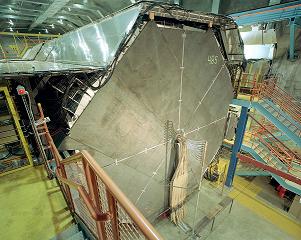
One of the neutrino detectors of the experiment Minos, USA. Notice the size of the stairs on the right. Neutrinos are extreme also by the size of the necessary equipment to detect them.
Extremely numerous:Every second, 65 billion of them strike each square centimeter of the Earth.
You can determine the fate of the extremely large: Scientists use neutrinos to study stars, galaxies, galaxy clusters and the rare gamma-ray bursts, the most energetic events ever seen in the universe, of unknown origin. Moreover, they are so numerous that if they have sufficient mass, even tiny, the gravitational field of all the neutrinos throughout space can influence the way the universe as a whole evolves - its expansion and the formation of galaxies. Definitely, size does not matter.
And what the group theorists do with these neutrinos? Well, the group name contains two words: "physics" and "astrophysics". Let's see what each of these terms refers to.
1. Regarding neutrino physics, they use them as a tool to test new theories of elementary particles. But why test new theories? The current one is not good? Not enough. It is true that modern theory called the Standard Model, formulated in the 1970s and based on the theory of special relativity and quantum mechanics is the theory that displays a better agreement with observations, among those built by humans today. But the agreement is not total. Therefore, we must improve it.
Therefore, how to improve the theory? One way is to build new theoretical models based on plausible hypotheses and test them. And the best way to test them is to compare their theoretical predictions with observations. The theoretical results, to be compared with experiments, are calculated by computer simulations (through software adapted by the group members).
Neutrinos are particularly prolific for these tests. They connect with many of the major theoretical problems of the moment in the field of particle physics. What GEFAN do, then, is to test new theories constructed by its members, comparing their predictions with the experimental results of neutrino observatories and laboratories spread around the world, some of them reviewed by other experimental groups at IFGW.
The Standard Model (the current theory of particle physics) works spectacularly well, at the point of being able to correctly predict a physical quantity to tenth decimal algarism, the so called "g-factor" of the muon, a number that goes in equations and physical which relates to the intrinsic magnetic behaviour of this particle, the muon. It is the first time that a physical theory can match the experiments so precisely. However, scientists think that this theory needs to be replaced. Why??
There are three types of reasons.
1. Philosophical reasons: Physical theories are only approximations of reality. It is always a matter of time before they reach their limits. That moment is exciting, because that's when people start to have "tips" on new physics and surprises that they can reveal.
Sometimes a theory survives for centuries before being replaced. Newton's mechanics lasted about 300 years. However, even at the time that the Standard Model was made, in 1974, one had practical reasons for knowing that it would be soon replaced by another theory - described in the following item:
2. Gaps: The Standard Model describes three of the four fundamental forces of nature - the electromagnetic, strong and weak - and leaves out the gravity. This latter theory is not yet suitable for the micro.
But for the most serious gaps: the Standard Model just does not give us tools to calculate various things that are within its scope. For example, while it provides very precise formulas to calculate the particles probabilities to transform into each other, it does not give tools to calculate them in the case of transformations between quarks - even though these changes are not banned (and happen in practice) . There are several shortcomings of this type in the Standard Model.
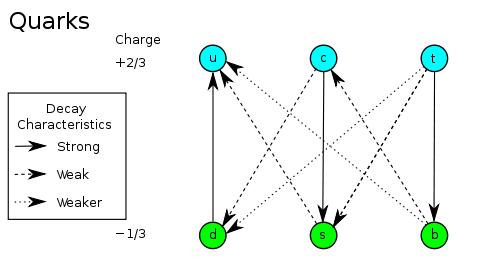
Diagram showing the possible transformations between the six quark u, d, c, s, t and b. The Standard Model, although it does not prohibit such changes (and even specify certain relationships between them), does not give sufficient tools to quantify its occurrence.
3. Discrepancies with experiments: These are obviously the most serious. Ironically, one of the discrepancies lies precisely in that calculation that was the cited as the most successful human endeavor to understand the theoretical nature: the agreement of ten algarisms after the decimal point of the muon g-factor, mentioned earlier in this box.
In 2006, at Brookhaven Lab, USA, precise measurements showed discrepancies with the theoretical prediction for the muon g-factor... at the eleventh decimal place! It's little, but the deviation is substantial enough to indicate that the limits of the Standard Model have begun to be overcomed in practice.

The latest figures for the value of the muon g-factor. The discrepancy between theory and observations (red) reaches the third last decimal place and is larger than the imprecision of both, which only reaches the last but one.
This may seem too small to condemn very strongly the Standard Model. But there is a discrepancy much less condescending. It just has to do with neutrinos. The way is constructed, the Standard Model prohibits three types of neutrinos to become each other. This is an automatic consequence of the theory, from a theoretical result with the charming name of "conservation of leptonic number." The particles are associated with certain numbers - for some neutrinos and other particles, called "leptons" - they should, according to theory, be kept as they are transformed into one another - as is, for example, the conservation of energy . However, in 1998 it was discovered that the neutrinos transform into each other. Therefore, there is something wrong with the theory! And this time, it is not a tiny shift: we are talking about the existence of an entire physical phenomenon.
All this leads to a very exciting job in both theoretical and experimental physics. We are living in interesting times! Again.
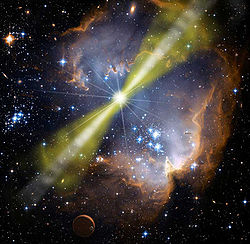
Artistic version of a model for gamma-ray burst GRB 080319B. The blast launched two opposite jets of matter (in white and yellow). Credit: NASA / Swift / Mary Pat Hrybyk-Keith and John Jones.
2. With respect to neutrino astrophysics, these particles contain important information about little known cosmic phenomena such as gamma-ray bursts (see illustration), which are among the most violent phenomena already observed in the universe and whose origin is not well known. The reason is that neutrinos are produced in large quantities by such events and interact very little with matter, arriving here with the information intact. As in the case of particle physics, different hypothetical theories about the causes of these phenomena can be tested by comparing its predictions with observations of neutrinos arriving on Earth.
Furthermore, the study of neutrinos can also be used to test cosmological theories, ie, on the evolution of the universe as a whole. As they are very numerous, their presence throughout the outer space can have influences on the formation of galaxies and galaxy clusters, processes that are not yet well understood. In the case of GEFAN, different theories about the possible influence of the properties of neutrinos in the evolution of the Universe are verified by comparing the results of their calculations with astronomical observations.
Let's consider these two strands with a little more detail.
There are three types of neutrinos. They are called "electronic neutrino", "muon neutrino" and "tau neutrino". They have these peculiar names because in most cases, when a electronic neutrino interacts with other particles, an electron appears, when a muon neutrino interacts, there is a muon, and so on. This is called a manifestation of conservation of lepton number: leptons of the same "family" (as "electrons" and "electronic neutrinos") appear in pairs. The electron is well known; as for the muon and tau particles, they transform into other particles only a fraction of a second after they are produced in very energetic physical phenomena (such as interaction of cosmic rays with the atmosphere or laboratory experiments).
These are the six particles called leptons, one of the three classes in which are divided the tens of elementary particles known (see box at the end of this text). Each pair "particle" - "neutrino particle" is called a "generation". In fact, each generation not only contains these pairs, but also a pair of quarks, as shown in the table at the end of the text box.
In 1998, it was found in the laboratory Superkamiokande, in Japan, that the three types of neutrinos can be transformed into each other. That in itself is very interesting, because it violates the so-called "conservation of lepton number," one of the rules governing the transformations between elementary particles. This law prohibits that neutrinos of different types become each other. Then, it is not working. It turns out that this law is a consequence of what we know about current theories of particle physics. So it does not seem possible to abandon it without causing substantial changes in the Standard Model. What's happening?" We need to change our theories or are we just failing to notice some important details? Only time and many experimental and theoretical research will tell.
It is not clearly understood, though, why the oscillations occur, nor how to match them with current theory. The group has done several studies in this direction. Several experimental teams around the world and IFGW gather data about neutrino observations (to learn more about them, check out our Lepton Group at IFGW).
The GEFAN compares these data with the predictions of various hypotheses that they formulate or improve for particle physics. For example, there may be more generations of leptons beyond the three known (the electron, muon and tau). There is no known constraint of nature that explains why there can be no more generations, or more pairs "particle" / "neutrino particle." The existence of more generations have consequences in theoretical particle physics in general that can be compared to observational data.
Another example is the assumption of the existence of new forces beyond the four known. Today we know that any physical force may be reduced to combinations of only four fundamental forces: gravity, electromagnetism, strong force - the known nuclear force - and the weak force - less known, but responsible, for example, the beta radiation (see box at the end of text). The group has explored the hypothesis of new forces - the so-called "non-standard interactions".
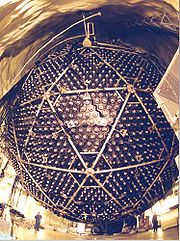
One of the detectors at the Sudbury Neutrino Observatory in Canada, who first observed the oscillation of neutrinos from the sun. Look at the size of the people around him.
Cosmic rays are formed of particles, as nuclei of atoms. If they achieve the atmosphere with very high energy, the reaction produces many new particles - which also in turn, react with air, and so on in a cascade process. In the figure below, it is seen cosmic rays producing first pions (which are particles formed by two quarks), they also react and produce muons, these in turn, produce electrons. As indicated in the figure, in each of these reactions neutrinos are also produced.
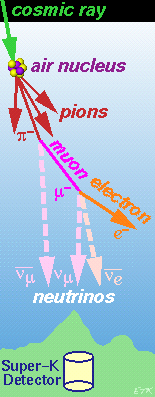
Source of figure: "Atmospheric Neutrinos", Physics Department at Boston University, USA.
Neutrinos can also be produced when cosmic rays from space collide with the upper layers of Earth's atmosphere.
Analysis of observational data on these neutrinos, called atmospheric neutrinos, and their comparison with the consequences of various theoretical assumptions about cosmic rays, allows to investigate their nature. There is plenty of open questions about it. To get an idea, the most energetic cosmic rays originate entirely unknown.
It is also possible to study the atmospheric neutrino oscillation. Moreover, they are very good to test new theories, because they allow to observe phenomena involving a large range of energy values with the highest value up to a thousand times the lowest.
Usually, astronomy research is looking at the light that stars emit and come to us. But it is also possible to observe neutrinos and other particles emitted by them, and they bring different information to us. It is a branch of astronomy called "Astroparticle Astronomy"
A star, for example, emit many neutrinos. But they are really useful to investigate certain rarer astronomical phenomena, very energetic and little known. Among them are active galactic nuclei (nuclei of galaxies that emit huge amounts of energy) gamma-ray bursts (the most energetic events known; it is not know what explodes, but it produces huge amounts of gamma rays) and magnetars (extremely dense objects - about 20 km in diameter but more massive than the Sun - and endowed with magnetic fields hundreds of thousands of times more intense than the most powerful magnets built on Earth).
Moreover, neutrinos are also useful for researching cosmology (which is the study of the universe as a whole - its origin, its destination, its evolution). Because neutrinos are so numerous, their properties can influence the actual evolution of the cosmos - or, in the framework of the scientist, can give indications of how this evolution happened. Specifically: how does the expansion of the universe, for the typical large clusters of matter such as galaxies and galaxy clusters, ended up with the average size that they have (different theoretical models produce clusters of different average sizes). Or how the general distribution of matter in the universe has formed, which seems to have a filamentary structure interspersed with vast empty spaces, like a sponge.
Another very mysterious cosmological problem is that no less than 85% of matter in the universe is invisible - it does not emit light or radiation of any kind (even neutrinos ...!) - And its nature is completely unknown. This is called dark matter. It seems to be distributed in large "wads" continuous-sized galaxies or even larger, rather than form clusters like ordinary matter, which joins on planets, stars, galaxies etc.. Its existence is known by the gravitational effects on galaxies around them. From what dark matter is made of? Nobody knows, but there are some candidates. The neutrino, that interact so weakly with matter, is a possible candidate for the dark matter, though it can not explain all of it.If all the dark matter was made of neutrinos, we would not observe the structure of galaxies as in the figure below (which shows the general structure of the universe observed, with 63,000 2dFGRS galaxies detected by the experiment). That is, if neutrinos were all the dark matter, there could be no major structures observed in the universe ...! Still, it is interesting to explore the consequences of the possibility of it being made of neutrinos. GEFAN has a research line that explore the consequences of these possibilities.
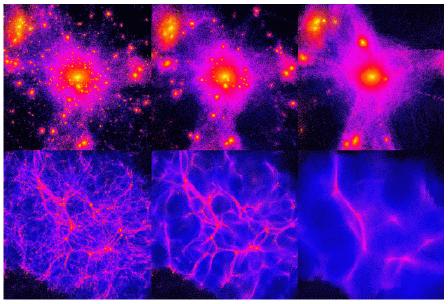
results of computer simulations for the evolution of the universe at large scale with three hypothetical situations in connection with three alleged different nature of dark matter. At the first one, the matter concentrates less because of the gravitational field, and at the latter, it concentrates more. The figures in the top show the stars seen in close-up, and in the bottom, the overall structure of the universe as a whole - it is filamentous, as shown by astronomical observations.
Source: RH Wechsler, SLAC Summer Institute on Dark Matter Structure Formation Lectures (August 2007).
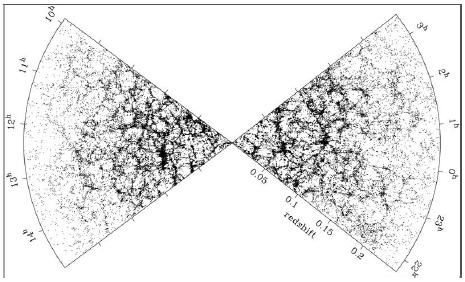
General structure of the universe observed, with 63,000 galaxies, as measured by the 2dFGRS experiment.Estrutura geral do Universo observada, com 63.000 galáxias, medida pelo experimento 2dFGRS.
Source: MM Colless, Carnegie Observatories Astrophysics Series, Vol 2: Measuring and Modeling the Universe, ed. WL Freedman, Cambridge University Press (2003). See also: Master's thesis of Daniel Francis Boriero, IFGW / UNICAMP (2008), p. 44-45.
Example of how the relationship of the general structure of the universe to the nature of dark matter is studied.
The presence of massive neutrinos in the cosmos can also produce gravitational effects on light, generating the so-called "gravitational lensing" distortions in the image of distant galaxies.
Recently, the group has also interacted with the experimental area through Neutrinos-Angra Project - along with members of the Group of Leptons, also of IFGW. The idea is to build a device capable of detecting the activity of the nuclear plants regardless of the information disclosed. This is possible because the nuclear reactor, as it runs, produces a large amount of very light particles called neutrinos, which can pass through the walls of the building of the plant almost as if they don't exist. When analysed, they provide information about what happens in the reactor.
It is then possible to have information about the power generated. This has two goals. One is the safety and efficiency of the plant itself. The other is the information on the amount of plutonium withdrawn and stored - which are typically sent by the Brazilian government to the International Atomic Energy Agency (IAEA), the UN body that promotes the peaceful use of nuclear energy, discourages their military use and monitors countries' nuclear programs.
The project, with support from the IAEA, is led by Unicamp and the Brazilian Center for Physics Research (CBPF) and has an agreement with Eletronuclear, also involving researchers from five other Brazilian institutions, and others from Italy, France and the United States. This is one of the first technological applications of physics of neutrinos to safeguards and nuclear nonproliferation.
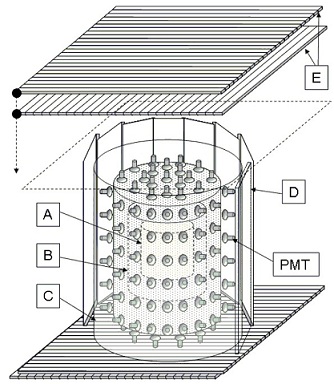
Angra Neutrino detector. A = the "target", consisting of one ton of liquid with small amount of germanium (the neutrinos interact with it and form new particles such as positrons and neutrons, which are detected by the other parties), B = gamma rays detector (produced by the interaction of positrons with electrons in the material), C = shielding against radiation from outside; D = veto system to eliminate signals from cosmic rays that are able to cross the walls.
Source: basic design of the detector (PDF) presented by Anjos et al.
The world is very complex, but its roots seem simple. All the diversity of the universe material seems to come from a surprisingly small number of "bricks" primordial.
Before describing this little "fauna", we must warn that not all particles "serve" to form atoms and molecules (as do electrons, protons and neutrons). Many simply are out there, wandering the area - such as neutrinos, which travel alone between stars and galaxies almost at the speed of light. Or are produced in various physical phenomena (such as the interaction of cosmic rays with Earth's atmosphere) and disappear a split of a second later, transforming spontaneously into other particles. Among the latter are muons.
Forces – The whole variety of physical forces seems to be reduced to combinations of only four fundamental forces, which are, in order of intensity: the strong force (the most intense, is known as nuclear force), the electromagnetic, the weak force (lesser known, but responsible for certain types of radiation such as beta radiation) and gravity. Everything else may somehow be described by means of combinations of them.
Matter – In addition, all known matter also appears to be a combination of only a few dozen types of elementary particles. They are usually grouped into three classes. Two of these classes are distinguished by the presence or absence of strong forces, and the third has a somewhat different nature. Let us follow in the table below (some squares groups several particles):
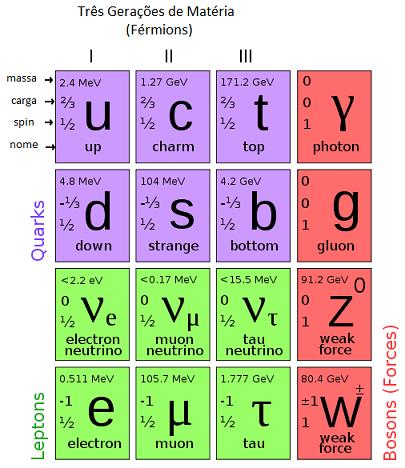
Quarks (purple) – interact together and with other particles via the strong force. Form protons, neutrons (each consisting of three quarks) and other heavy particles. Are six in number: up (u), down (d), charm (c), strange (s), top (t) and bottom (b). The proton comprises two up and one down, the neutron, two down and one up.
Leptons (green) – what characterizes them is that they do not interact by strong force. They are also six: electron (e), muon and tau, and three types of neutrinos - called "electronic neutrino", "muon neutrino" and "tau neutrino", because they have similar properties to the corresponding particles.
Gauge bosons (red) – particles that are "mediators" of the four fundamental forces. This means that those forces manifest, microscopically, as streams of particles. For example, electric and magnetic forces are manifested as streams of photons. Forces manifest themselves as strong flows of gluons, and weak forces, as streams of particles called W and Z particles. It is assumed that the gravitational force also corresponds to a flux of a particle called the graviton, but it has not been observed yet (not necessarily because it does not exist, but because its mass is much smaller than the ability of current instruments to detect it).
Besides these particles, there are also a "mirrors" of them, called antiparticles. Each particle corresponds an antiparticle, with some properties reversed, as the electric charge - except for the photon, which can be considered its own antiparticle. The antiparticles form antimatter.
Notice that, as far as is known, the electron is an elementary particle - no internal structure - while the proton and neutron are not - are made up of three quarks each.
Let us return to the table. Note that the particles are alternatively classified into three "generations" in the first three vertical columns. (Indicated by I, II and III) This is because there are certain symmetry relationships between the particles of the same column. Why there are only three generations is one of the unanswered questions that physicists have addressed today.
The GEFAN emerged from conversations of some researchers in the field of particle physics, but of different specialties, who would like to emphasize, in their investigations, the neutrinos. Among them were Vicente Pleitez, from the Institute for Theoretical Physics at UNESP, Renata Zukanovich Funchal, USP, and Marcelo Moraes Guzzo, Group of Theoretical Physics at IFGW. The meetings came forward from 1992. There was a learning process of the new sub-area, began to guide people, people were sent abroad and people from abroad were added to the team. An informal group was established, with meetings at Unicamp, USP and UNESP, and these scientists began collaborating on several research among themselves.
The original intention was to use neutrinos to test fundamental properties of elementary particles related to current theory, the Standard Model. For this, members of the informal group that belonged to IFGW formed the Group of Physics and Astrophysics of Neutrinos. The collaboration with researchers from USP and UNESP, in turn, continued.
The research has been diversifying with the arrival of new researchers: research were introduced with supernova neutrinos, solar neutrinos, non-standard interactions and the relationship between neutrinos and cosmology.
Universidade Estadual de Campinas - Instituto de Física Gleb Wataghin
Rua Sérgio Buarque de Holanda, 777
Cidade Universitária, Campinas - SP, 13083-859
Fone +55 19 3521-5297
Fax +55 19 3521-4147